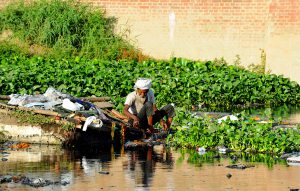Ahead of its Spring Meetings, which ended on April 17, the World Bank released a Climate Change Action Plan (CCAP) that sets out the institution’s work on climate change from now until 2020, the same timeframe guiding the Paris Agreement.
By 2020, the Bank hopes to provide US$29 billion (187.4 billion yuan) for climate projects, nearly triple its current average per year. This would increase the percentage of Bank funding for climate from 21% to 28% of its total portfolio.
Directing 28% of the Bank’s budget towards climate action could do a lot to reorientate capital markets towards renewables, support sustainable urban infrastructure and strengthen the resilience of communities vulnerable to climate disaster.
Unfortunately the old adage ‘quality over quantity’ may apply here. For one, the CCAP repeatedly references hydropower as ‘renewable’. Large hydro has a long and complicated history at the Bank. The Narmada Dam and other movements called global attention to the displacement, lost livelihoods and irreversible environmental impacts that dams cause.
Yet over the past several years, the Bank has returned to promoting mega-dams as a green, affordable option for getting power to the poor, promising it can get large hydro ‘right.’
In December 2015, 500 organisations from 85 countries signed onto a Civil Society Manifesto for the Support of Real Climate Solutions to keep large hydro out of climate finance.
They cite a number of reasons, including that dams disrupt rivers’ natural function as carbon sinks and do massive damage to freshwater ecosystems. Perhaps most compelling is that mega dams rely on a central grid, so their potential for providing rural electrification is low. This means that the energy they produce is more likely to go to large industrial projects than to the poor.
Another area of concern in the World Bank plan is its treatment of forests. The CCAP notes that between 2002 and 2015, the World Bank Group has financed US$15.7 billion (101 billion yuan) in projects with forestry components.
A recent study shows, however, that development finance for forests is less than 3% of the total annual portfolio for the IBRD/IDA, which includes concessional finance for the poorest borrowing countries. This begs the question of what indigenous and forest-dependent communities will ‘net’ from World Bank investment in forests vis-a-vis its investment in sectors that drive deforestation like energy, mining and transport.
The CCAP promises that “WBG organisation is now aligned to deliver on climate change”. While top-level Bank officials may be poised to take on climate challenges, at least with their discourse, questions remain around the readiness of their counterparts at the operational level.
Often, screening projects for climate impacts takes the form of ‘toolkits’ and ‘guidance notes’ for discretionary use by project task teams.
These documents tend to focus more project’s climate impacts rather than the project’s resilience to climate change-related events.
Furthermore, the linchpin for real climate action at the World Bank should be the assessment of alternatives to fossil fuels.
The Bank should require accounting on greenhouse gas emissions for the full life cycle of projects before they are approved, determine the social costs of carbon (i.e cost-benefit analysis) and whether these warrant consideration of alternatives.
While the value of up-front assessment seems self-evident, the World Bank Board has thrown its support behind Bank management’s new ‘adaptive risk management’ strategy, which narrows the scope of the Bank’s required due diligence and allows borrowing countries flexible time schedules for identifying and addressing environmental and social risk.
This means that even a climate safeguard could prove ineffective in preventing carbon-intensive projects from reaching a Board vote. This has serious implications, especially given the Bank’s ongoing consideration of lending to the Kosovo C lignite coal-fired power plant.
What’s more, World Bank lending through policy loans is subject to far fewer requirements for environmental and social assessment, and would not even be covered by the proposed climate safeguard.
This risks World Bank funds going to support policies and subsidies that incentivise fossil fuels – yes, even coal – thereby cementing carbon-intensive development paths for countries whose poor will be hardest hit.
While the potential of the Bank’s target 28% towards climate initiatives is commendable, the real question is: how will the Bank ensure that the other 72% of its portfolio meets the standards set by its lofty climate goals?






